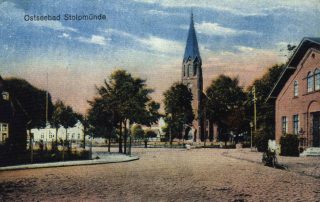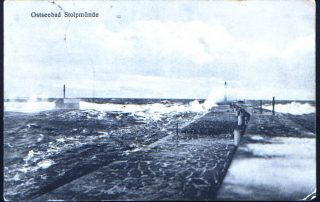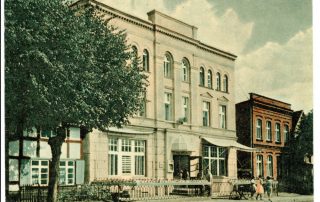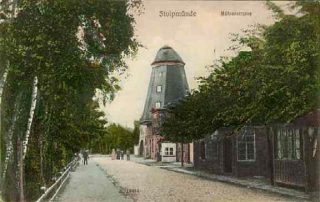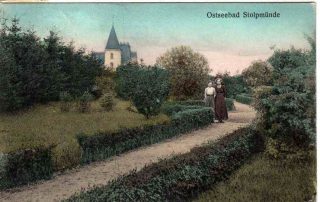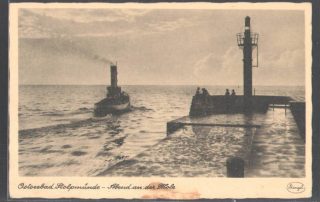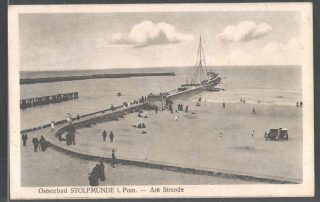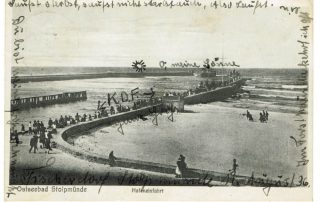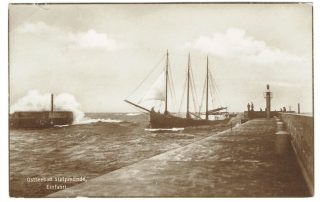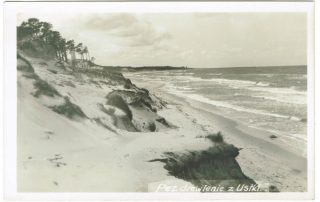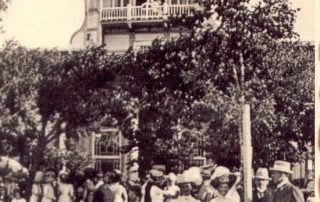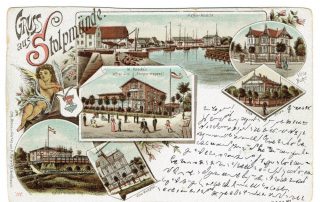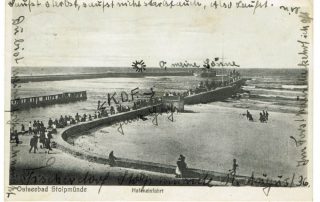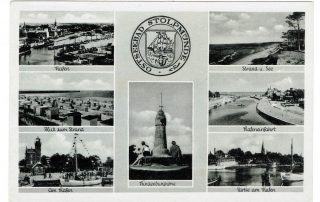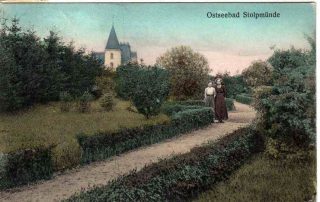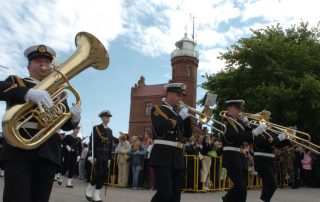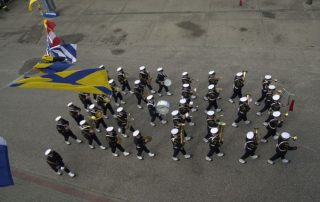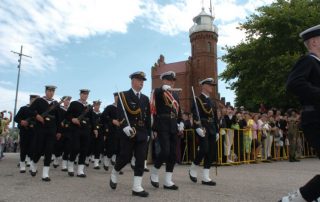THE CITY HISTORY
THE HISTORY OF USTKA
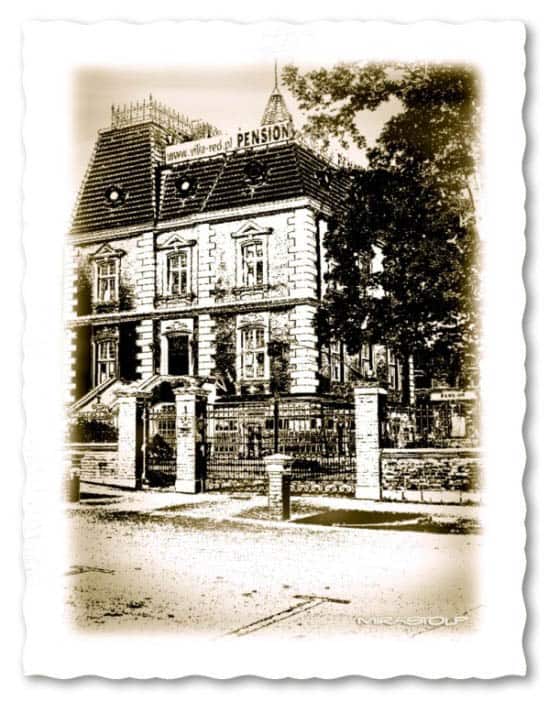

The Story of the City
In the history of Ustka, from the earliest times to the newest, we can clearly see three sources of income, shown in the coat of arms of the city, designed in 1920 by the local artist Wilhelm Granzow. It involves fishing (salmon in the hand of a mermaid), commercial shipping (sailing ship) and bathing resort (mermaid immersed in the sea). The oldest inhabitants were fishermen and sailors.
Accidental archaeological finds indicate that the mouth of Słupia was inhabited already in the Stone Age. The salmon-packed river attracted fishermen. As far as in prehistoric times, behind the dunes, in dry, sheltered places, people would built huts and use wooden vessels for fishing. They could also hunt seals, many of which lived on empty beaches at the time. It can be presumed that in antiquity there was a settlement located near the Przewłoka estate. The 1970s marked a discovery of a cemetery from the period of Pomeranian culture, i.e. from 2.5 thousand years ago. The people of this culture had a mysterious relationship with the Etruscans in Italy, which manifested itself in the funeral rite that consisted in pouring the ashes of the dead into urns with the image of a human face.
Many finds from later times testify to contacts of the local sea inhabitants with Scandinavia. Characteristic are the “Fossilized Bells”: two boulders in the forest near Poddąbie (10 km east of Ustka). They are a remnant of a tomb from the period of the Wielbark culture, combined with the presence in Pomerania of the Goths, Scandinavian warriors who sailed across the Baltic Sea, and headed south to destroy Rome 400 years later.
Pomerania, Prussia, Poland.
The history books were changed by Ustka at the beginning of the 14th century, when Władysław Łokietek made attempts to unite the Kingdom of Poland following the feudal fragmentation. However, its paths with the Polish state then parted for many years. On July 17, 1307, Pomeranian lords coming from the Święc magnate family originating from Słupsk, who owned huge estates such as the one in the castellany of Słupsk, including Ustka, concluded a pact with the margraves of Brandenburg in Lędów (3 km from Ustka). In exchange for keeping offices and estates, they surrendered Slupsk and Gdańsk Pomerania to the Brandenburgs, contributing to the loss of this district by the Kingdom of Poland for many years. Until 1648, Ustka, together with the superior Słupsk, remained in a separate West Pomeranian Duchy, and later until 1945 in the Brandenburg-Prussian state, followed by the German Reich. This area was inhabited by the Slavic Pomeranians; with time, when German colonists began to settle here (mainly from Lower Saxony), they were gradually Germanized. But here and there, in places like Lakes Gardno and Łebsko (14 km from Ustka), they retained their ethnic identity till the beginning of the 20th century. After World War II, Ustka returned to Poland.
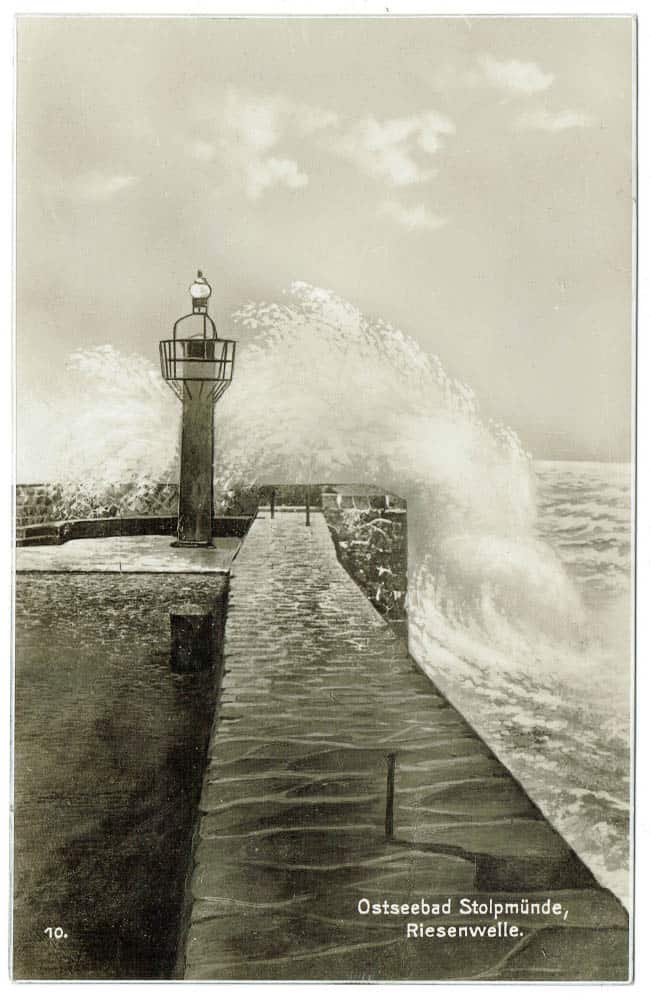
A Port for a Pair of Shoes
But we should return to the Middle Ages. Thirty years later, on February 2, 1337, the Święcowie sold Ustka to the German burghers of Słupsk (hence the aforementioned superiority). It was in connection with this transaction that Ustka was mentioned by name for the first time in a written document as the Stolpesmunde Port, or “Słupioujście”. And so, until 1945, this was its German name. Native, Slavic, recorded in the 12th century as “Vzt”, in the 19th century it was certified by researchers of the Kashubian region (Kashubians, as mentioned, still lived in the area of Gardno and Łebsko lakes) as Vuska or Wusko, i.e. Ujście (The Outlet). Słupsk bought Ustka with plans to expand its commercial seaport. The price was an obligation to give both knights from the Święc family and their descendants a pair of shoes or its equivalent in the amount of 8 Slavic grosz once a year on November 11.
Maritime trade, the second chronological function of Ustka, brought big profits mainly to Słupsk, and to a lesser extent to Ustka. To this day, the impressive buildings in Gród nad Słupią, erected in the Middle Ages and later, testify to this. Sailing vessels belonging to the merchants from Słupsk, departing from Ustka, reached places like Swedish, Danish, Dutch, French and English ports as well as the Polish Gdańsk, from which the ships sailed here. Unloaded in the port were salted herring from Scandinavia, French wine, salt from Kołobrzeg, smoked salmon, wood, Słupsk beer, as well as agricultural and amber produce.
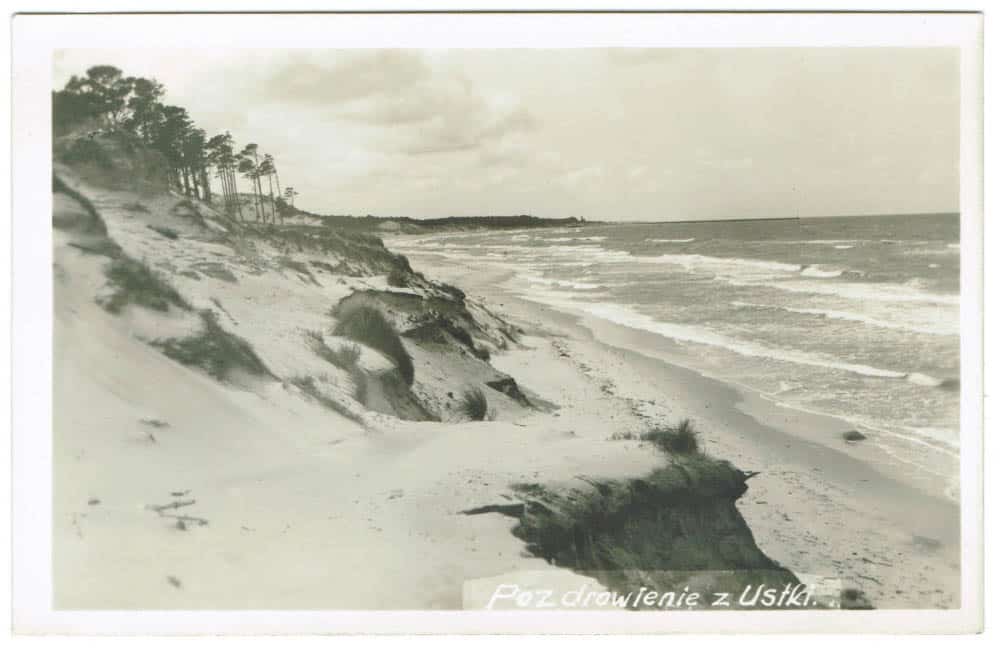
50 Houses, 6 Inns…
The inhabitants of Ustka were the crews of these ships, and some were their captains. They lived on shipping, port and fishing. The settlement often welcomed foreign visitors. The ship’s entry into port was the most anticipated event; according to the statute of 1640, in exchange for help in mooring the sailing ship, the captain was obliged to buy a barrel of beer for the Ustka people. At that time, there were as many as 6 inns operating in the settlement with a little more than 50 houses. The dependence on Słupsk was manifested in the fact that they had to pay taxes and duties to Słupsk and perform commands of the Head of Village appointed by Słupsk councilors. They also had to take an oath of allegiance to Słupsk – whoever failed to do so could not register to marry. Conflicts arose against this dependence between the Ustka and the Słupsk people.
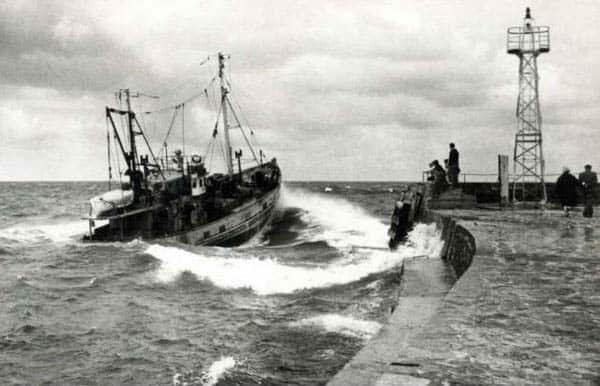
Marked by Sails and Steam
Another important date in the history of Ustka is December 22, 1831. At that time, Słupsk surrendered the port, which it had purchased almost 500 years earlier, to the Prussian state. This was because it was unable to ensure the dredging of the waterway, which was constantly silted by the river and by the sea current that carried in sand and made the entrance to the port shallow. The Prussian authorities were able to bear these costs. At the beginning of the 1860s, they allocated 250,000 thalers on modern, stone piers, which replaced wooden decks. Another large-scale investment took place in the years 1899-1903, when both piers took their current shape. The depth in the port increased to 5-6 meters, so that larger steam vessels could also enter. But commercial sailing ships appeared in Ustka already at the end of the 1940s. At that time, mainly agricultural produce was exported from here. The granaries on both sides of the port have survived to this day. An important export product was also spirit from Pomeranian distilleries, transported to Hamburg by a special tanker. The building in which this valuable liquid was stored has survived to our times as well. Importation included mainly coal from England, herring and stones from Scandinavia, and fertilizers. Until World War II, the port in Ustka was the largest structure of this kind between Gdańsk and Świnoujście. But the largest traffic was recorded there already in Polish times, in 1948, when 759 Swedish, 208 Danish, 65 Finnish and 3 Norwegian ships arrived to the port for coal. It is worth adding that just before the outbreak of World War II, Nazi Germany intended to expand the Ustka port to the size of Gdynia. Preserved from that time is the stump of an unfinished pier on the west beach. The money drowned by the Nazis in this investment could have allowed the maintenance of the then school in Ustka for 10 thousand years! The port’s trading activity was abruptly cut short during the Stalinist era and never revived again in its scale of 1948. In the 1990s it completely died out.
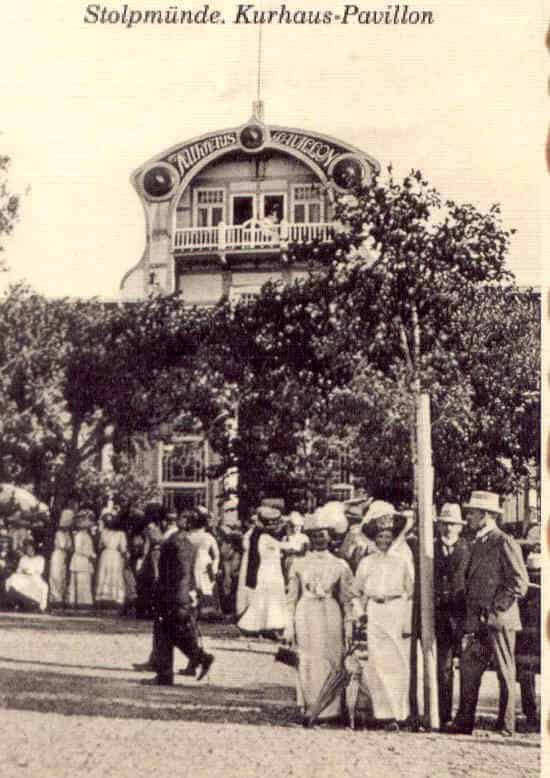
Summer and Health Resort
Summer and health resort is the chronologically youngest economic function in Ustka, which after 1989 grows to the rank of its most important role. The first mentions of holidaymakers (38 families) who had come here for a vacation in the summer originate from 1832. They arrived in carriages, or hired carts, and then by stagecoaches at local fishermen’s huts, in which they would rent rooms. The journey from Słupsk took an hour and 45 minutes. Later, bathhouses were built, i.e. an institute of natural medicine, bathing cabins and a promenade by the sea (1875). After the railway line had been brought to Ustka in 1878, the number of summer tourists visiting the settlement increased to several thousand every year. It was then that the residential and guest house district was established to the east of Kosynierów Street, the most representative streets of which were Żeromskiego and Chopina. Until 1945, the greatest number of visitors arrived from the Berlin agglomeration, then from Saxony and Silesia, but visits would also be paid by wealthy Poles, even though until 1945Ustka belonged to the German Reich. The holiday and sanatorium character of the village from 1922 was accentuated by the official name of Ostseebad Stolpmunde, i.e. the Baltic Spa. Already at that time, spa visitors were advised walks along the beach. It is worth adding that one of the first admirers of beach strolls was Prince Otto von Bismarck, who enjoyed a stay here twice (1856 and 1858) and was a fan of trips to Orzechowo. From January 1, 1988, Ustka has had the status of a health resort, granted by a resolution of the Council of Ministers. However, it is worth remembering that it is probably the only city in Poland that has probably never been formally given urban rights.
Opracował: Marcin Barnowski
CALENDAR OF HISTORICAL EVENTS



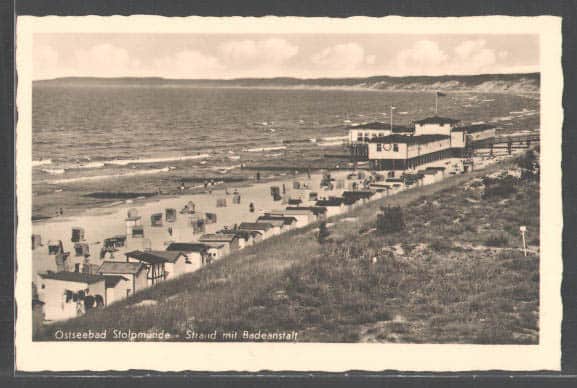
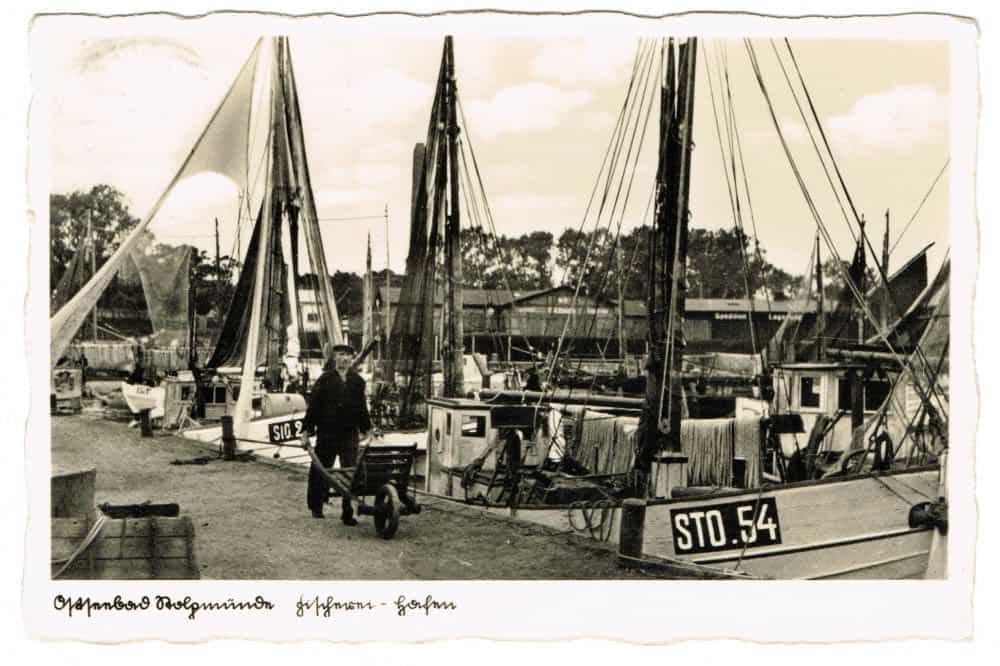
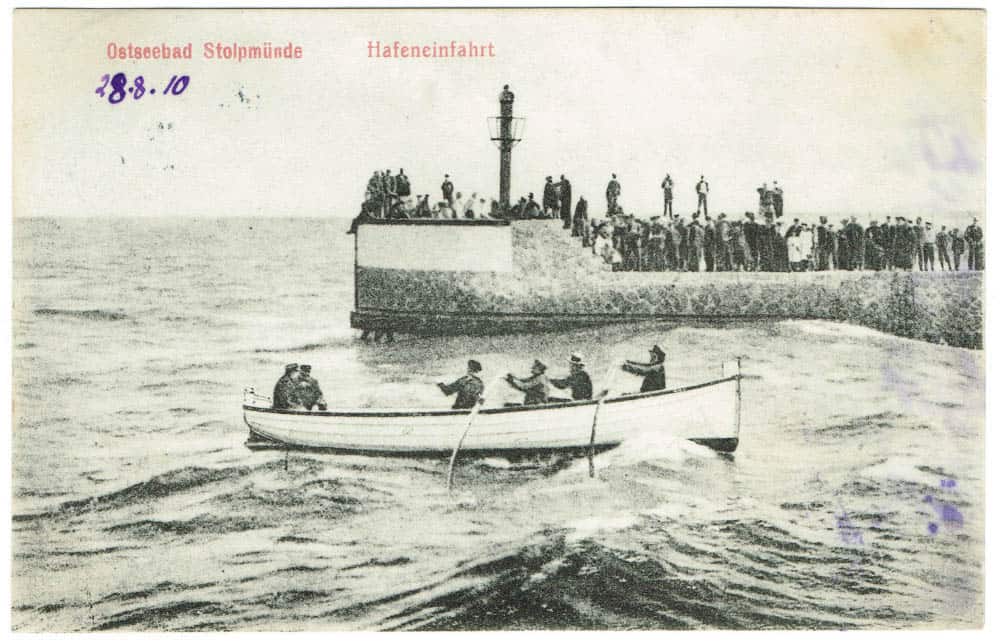
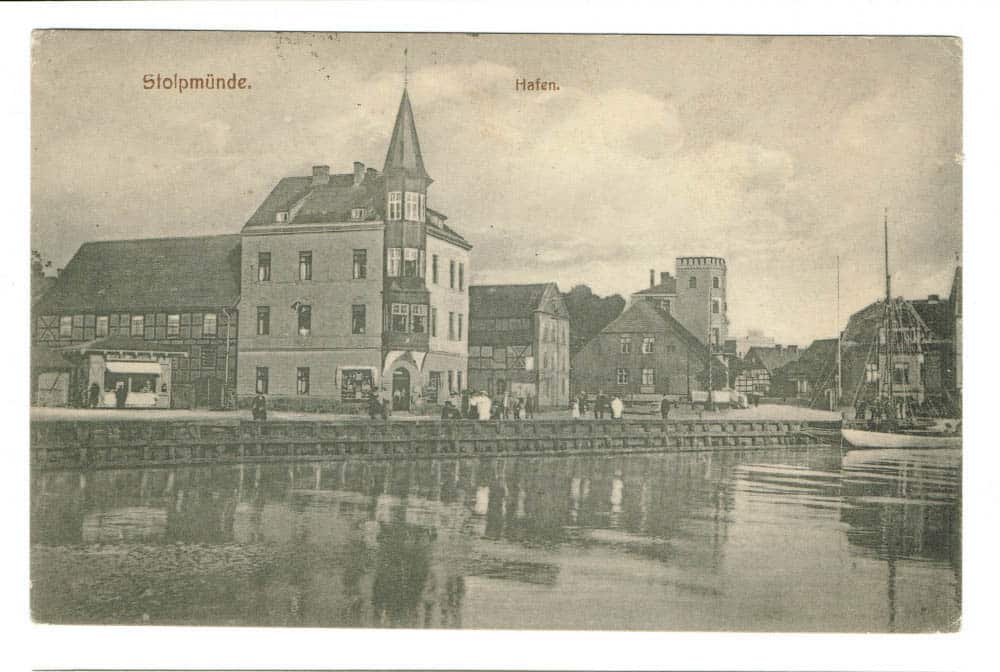
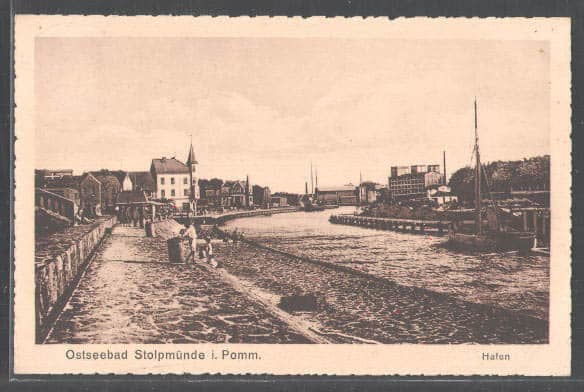
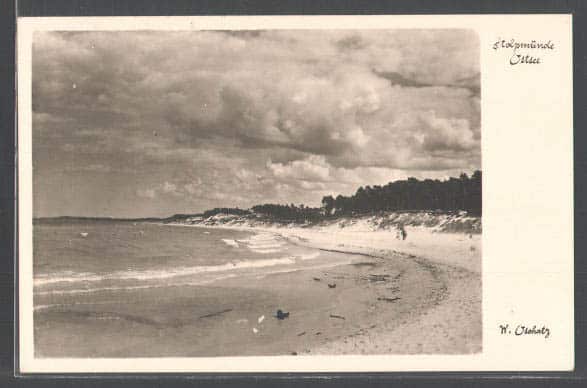
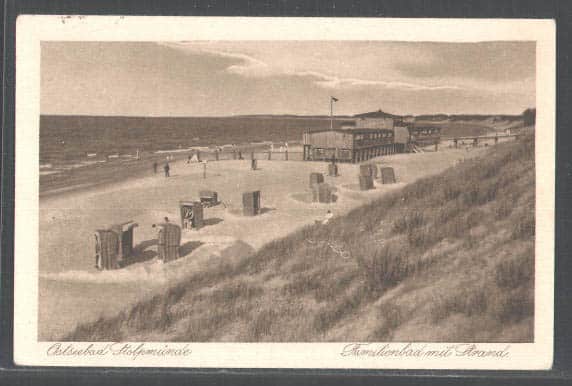
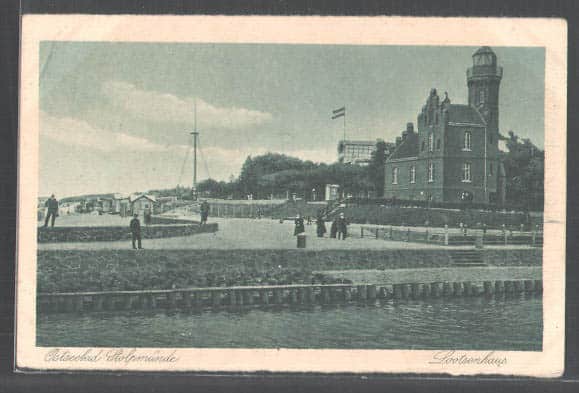
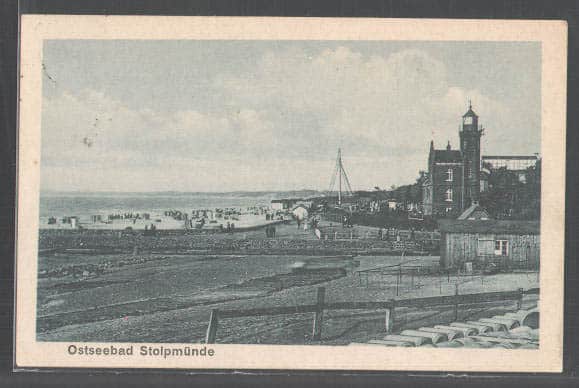
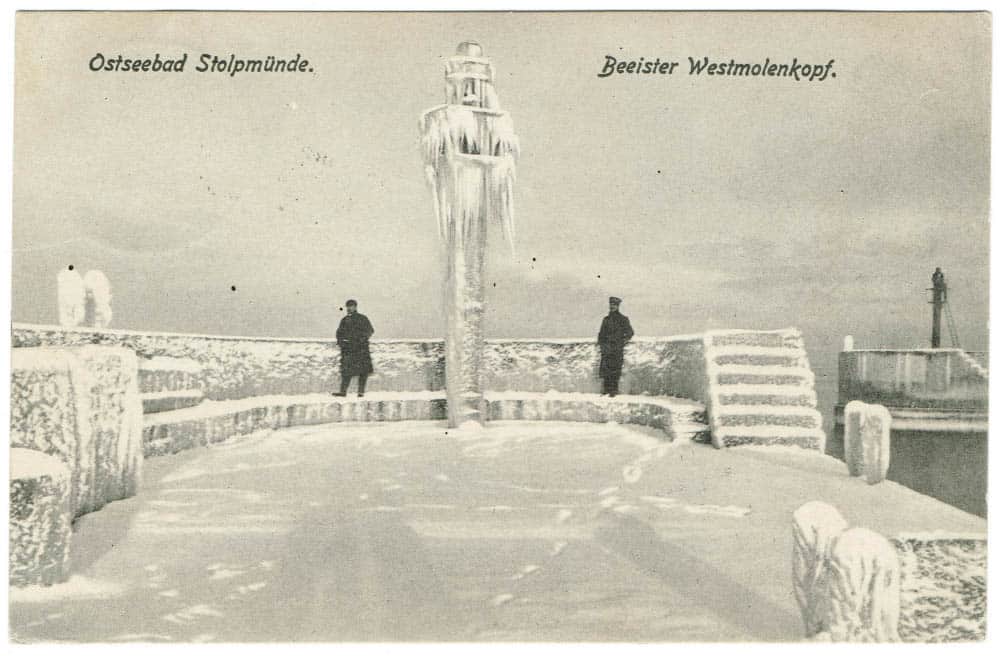
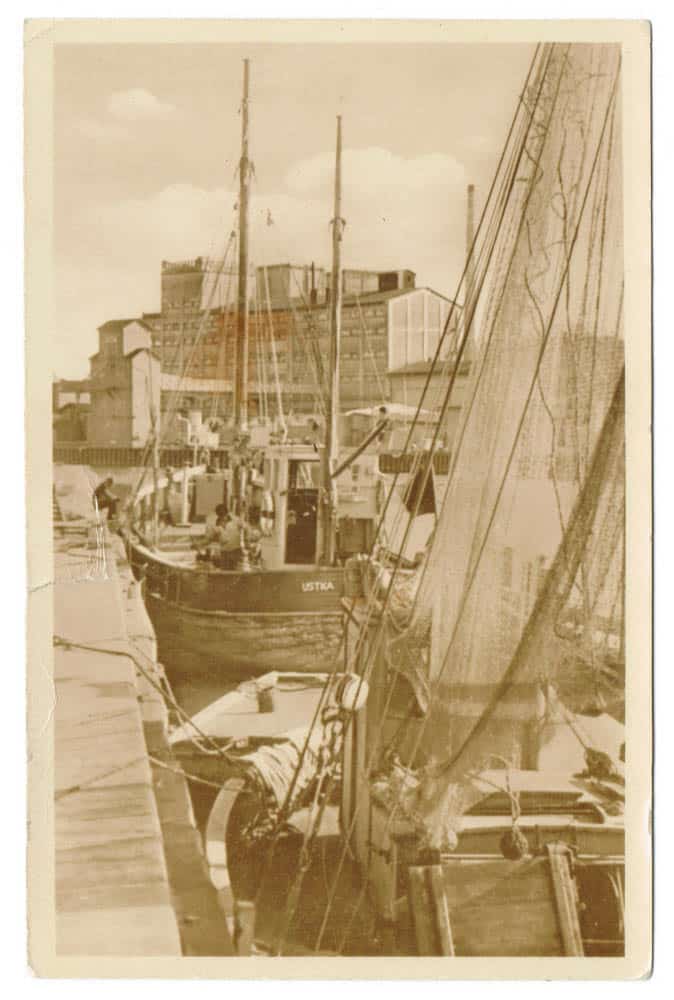
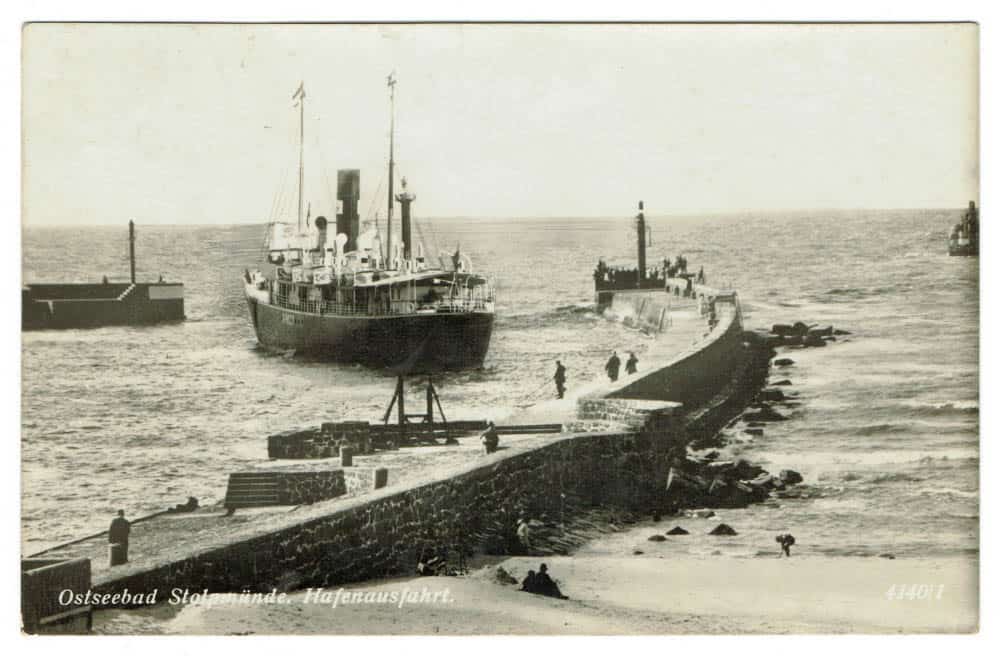

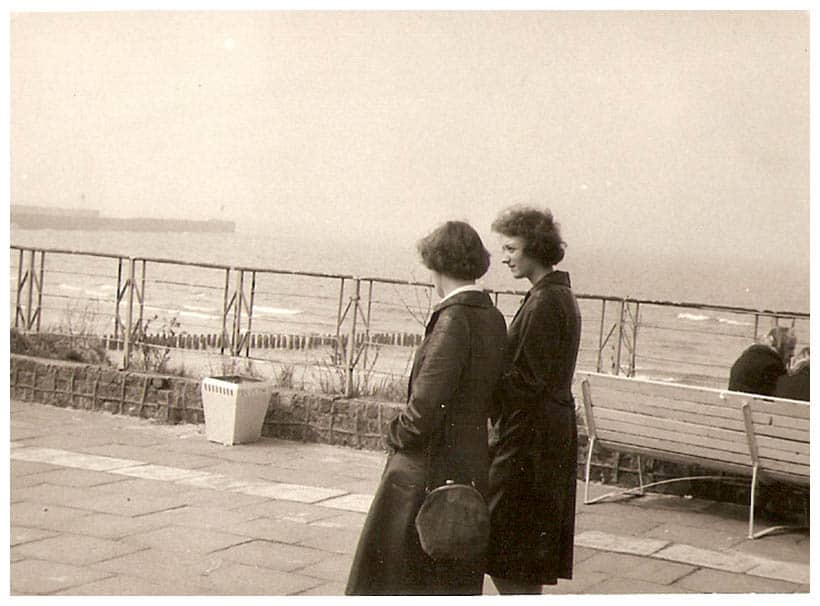
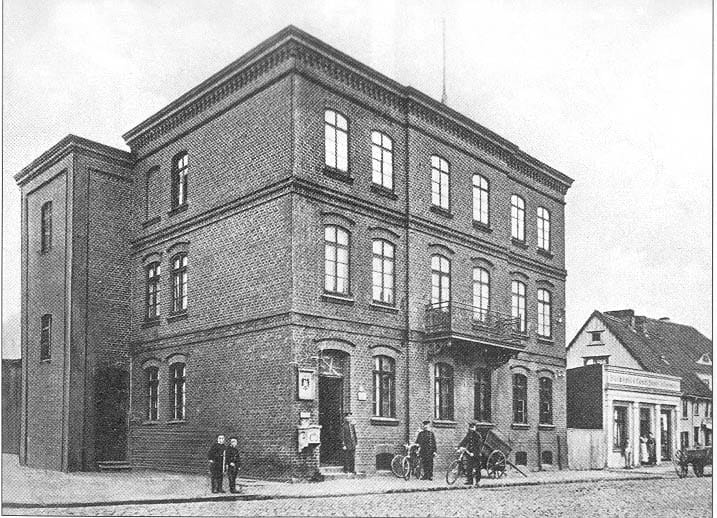
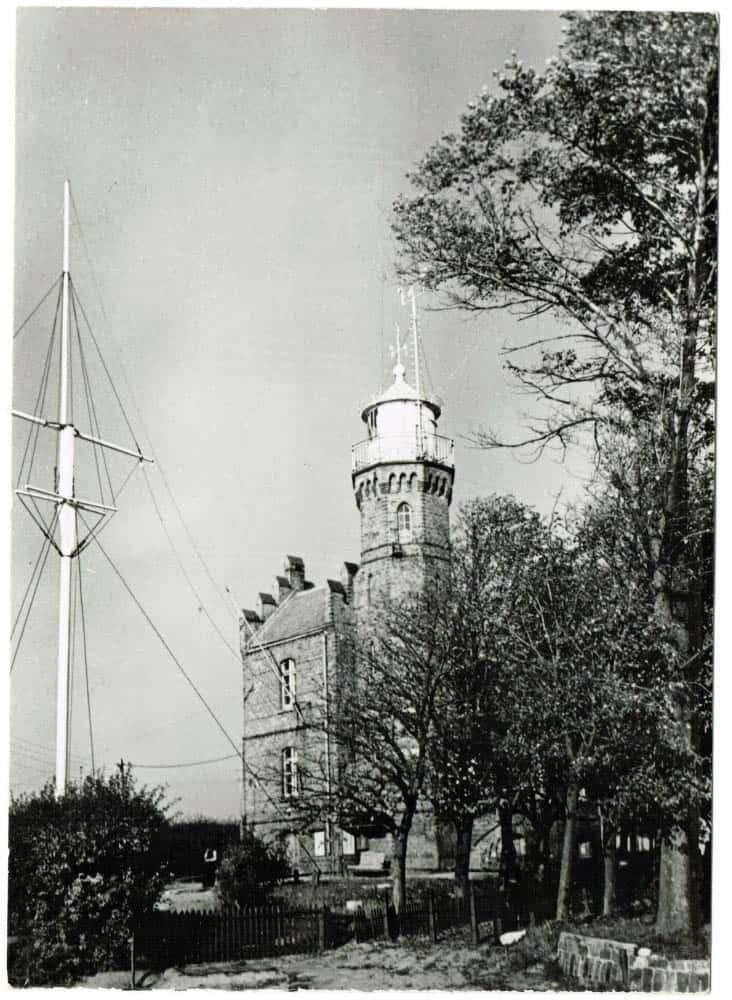
Some Dates and Events
The city in its modern form started to emerge at the turn of the 18th and 19th centuries when, after two challenging centuries, the fishing port at the mouth of Słupia began to grow in importance again. Ustka also gained administrative independence (bidding farewell to the sovereignty of Słupsk councilors dating back to the 14th century with joy). The dynamic evolution of the settlement occurred for the first time between the end of the Prussian-French war (1871) and the outbreak of World War I (1914), and for the second time in the last quarter of the century. However, if we looked at the written history of Ustka or Słupioujście (as sounded the 14th century German name for the port at the mouth of Słupia to the Baltic Sea), the last two centuries constitute only 1/4 of the history of Ustka. Below we have selected dates and events in the history of today’s summer capital of Poland which we believe to be important.
1310 (September 9) – on the occasion of extending the urban rights of Słupsk, the Brandenburgs, who ruled this part of Pomerania at that time, guarantee the city “exempt of duty and tolls, by building no weirs, free (sic) navigation on the river from the city down to the sea (…) “. Słupsk also obtains the right to own 6 fishing vessels, the so-called bordyna;
1313 (February 2) – Słupia’s rights to Słupia were extended, giving the city a strip of land along the river with a width of 5 bars (about 19 m), which made it possible to pull boats or rafts from the shore. On top of that, Słupsk is given the right to purchase forests and pastures by the river and takes over the “lease” of the port and port settlement located at the outlet of Słupia to the sea, for which it is obliged to provide the Święc (owners of rights to coastal areas at the mouth of Słupia) a pair of leather shoes worth 8 Slavic “solids” or its equivalent every year for Saint Martin (11 November)
1337 (February 2) – the Święc brothers (Jaśko from Darłowo and Jaśko from Sławno) sign an agreement with the town councilors of Słupsk, which finally grants them the right to Ustka. The contract clarifies that Słupsk receives “(…) also the entire and indivisible port of Ustka, located on both sides of the Słupia River (…)”;
1356 – there is mention of the existence of a Church of St John and St Nicholas, constituting a parish chapel in the nearby Zimowiska;
1382 – Słupsk joins the Hanseatic League; the port in Ustka is expanded over several decades and takes over maritime trade services in the city – the goods transported from here were delivered to recipients in the Netherlands, Denmark, Sweden and even distant England; ca.
1440 – the port of Ustka becomes the leading center of this type in the eastern part of the Duchy of Pomerania, overtaking (in terms of the amount of transshipped goods) the ports of Darłowo and Kołobrzeg;
1535 – the inhabitants of Ustka convert to Protestantism;
1590 – the princely inspector records the existence of a school in Ustka;
1623 – an open revolt of Ustka’s inhabitants against the restrictions imposed by Słupsk breaks out; the tumult is pacified by military units sent from Słupsk;
1626 (November 2) – a unit of Swedish troops passes through Ustka to protect the port against the Scandinavian invasion, the mouth of Słupia is fenced off with a wooden log, probably fastened to the port quay on chains;
1630 – the Swedish army occupies Słupsk and the port in Ustka during the Thirty Years’ War;
1644 – the village is destroyed by a huge fire, only the Church of St. Nicholas and 15 buildings will survive;
1648 – under the Peace of Westphalia that ended the Thirty Years’ War, the eastern part of Pomerania (including Słupsk and Ustka) is granted to the Brandenburg electors;
1667 – a winter storm destroys port equipment, and quicksand significantly covers the Słupia estuary to the sea; the visitors describe the condition of the port as hopeless, and the Brandenburg elector imposes an extraordinary tax on the reconstruction of the port in Ustka, which was then carried out in the years 1670–1671;
1674 – the outbreak of the Swedish-Brandenburg War contributes to the collapse of maritime trade in the Baltic Sea. The unused port falls into decline and remains largely unused, it is then heavily damaged during a powerful storm in December 1690. Słupia finds a new outlet to the sea, and the old one (constituting the port entrance) is silted again;
1695 – ship traffic is restored to the port, but for years the estuary is very shallow and the harbor can only be used by small vessels; 1778 (August 1) – a big fire destroys 18 out of 37 farms in Ustka;
1787 – Słupsk merchants keep 12 commercial ships in Ustka with a total capacity of 1080 ha; in the following years the number of ships stationed here rises slightly;
1808 – the French order closure of the cemetery around the Church of St. Nicholas and designation of a new burial place outside the village;
1812 – at the request of the French, an earthen and wooden bulwark with two cannons is erected at the port to protect it against possible invasion of British ships (being at war with Napoleon at the time);
1820 – the first summer vacationers arrive to Ustka, taking advantage of hospitality in the houses of local fishermen;
1831 (September 22) – Słupsk loses the ownership of Ustka and the port on Słupia to the Prussian state;
1863 – the expansion of the port in Ustka begins (150,000 of the then marks were allocated from the state treasury). It was completed in 1865, thanks to which the port’s capacity increased to 500 ships per year; a year later, an additional 34 ha was purchased for further modernization of the port and associated facilities;
1867 – a Sea Rescue Station (today called the Red Shed) is built and equipped at the port;
1854–1858 – Otto von Bismarck comes to Ustka with his family for a summer vacation;
1870 – a Bathing Society is officially established with the aim of developing the Ustka summer resort; separate bathing rooms for men and women with children were built – men were located on the west side of the Słupia estuary (at the level of today’s Blücher Battery), while women and family bathhouses were placed on the eastern beach, at the level of the central part of the promenade;
1871 – a port pilots’ station is established on a hill on the eastern side of the port. The 11.6 m high mast built next to it served as a lighthouse;
1875 – a seaside promenade is opened for spa visitors; it leads from the port towards Orzechowo; meanwhile, alleys are marked out and the first trees are planted in today’s seaside Spa Park;
1878 – Ustka launches a railway connection with Słupsk;
1885 (May 18) – the cornerstone is laid for the construction of a new church (at the southern end of the then village);
1886 – a residence, probably for Chancellor Otto von Bismarck (today’s Villa Red), is built to the north-east of the city on state-owned land; in the port, on the west side of the river, a huge spirit store with a capacity of 2.5 million liters is put into use;
1890 – a floating excavator is purchased for the purpose of the port’s operation; on an ongoing basis, it dredges the fairway, keeping the depth not less than 8 m;
1892 – the reconstruction of the pilot station (pilot book) is completed, in the course of which the hitherto pointed helmet crowning the station with a gallery and a lantern was replaced (which in turn was completed in 1904);
1899 – the beginning of a major reconstruction of the port and the outlet of Słupia to the sea, completed on September 24, 1903; built are concrete breakwaters which reach the mouth of Słupia to the Baltic Sea and run approx. 500 m into the sea. Thanks to the investment, the introduction of sands to the mouth of the river by sea currents is stopped;
1903 – 46 coastal and deep-sea fishermen from Ustka set up an association for the development of a fishing port;
1904 – a municipal gasworks is built;
1909 (October 1) – Ustka becomes the seat of the parish, including the former seat of the pastor – the church in Zimowiska;
1911 – the local power plant is launched;
1911 (August 18) – a direct railway connection between Ustka and Sławno is launched; as part of the construction of the connection, the railway station is also being expanded (to the existing form);
1912 – a magnificent elementary school is built (today it houses the Town Hall); a natural medicine (balneological) facility is opened near the seaside promenade;
1914 – due to the destruction of the men’s bathhouses by a winter storm (on the western side of Ustka), the eastern bathhouses are expanded, with some of the cabins intended for men;
1914 (September 13) – a fire breaks out in the grain silo and devours 400,000 quintals of grain; a year later, a new granary is established in the place of the burned building;
1915–1918 – there is a small prisoner-of-war camp for Russians in Ustka; as part of their work, the POWs arrange the Hindenburg Mountain viewpoint, located at the seaside promenade, east of the governmental villa of Bismarck (today’s Villa Red);
1922 – Wilhelm Granzow from Duninów designs a coat of arms for Ustka, which portrays a ship and a mermaid holding a salmon; a modified version is still in place today; Granzow’s coat of arms was placed on the pedestal of the obelisk and unveiled in the same year, commemorating the inhabitants of the fallen in World War I, the so-called “Dying Warrior” by Joseph Thorak;
1925 – the Ustka fishing fleet consists of 102 cutters and boats; eight years later (in 1933) there are 176 fishermen and 53 active smokehouses in the city;
1928 – Ustka hosts 3,003 summer visitors during the summer season;
1928–1930 – construction of water supply and sewage systems;
1935 (March 22) – Ustka is transformed from a village into an urban settlement (henceforth the Head of Village was replaced by the mayor); although Ustka was not formally granted urban rights at the time, after 1945 this date was adopted as that of granting city rights;
1936 – plans for another expansion of the port in Ustka and the creation of the main port at the mouth of Słupia to handle trade with East Prussia are approved; approx. 500 m west of the Słupia estuary, the construction of a new western breakwater was started, the length of which was to be 1,680 m. As part of the works, the eastern breakwater was to be extended by 385 m; parallel to the west of Ustka, the largest training ground in Germany at that time was marked out; on the border of Ustka and Lędów, the construction of barracks and the buildings of the later aviation school (today they house the Naval Training Center) is started;
1937 – at the base of the western breakwater, a station for the Blücher Anti-Aircraft and Barrier Battery is built (range approx. 17 km);
1938 – the modern Hitler Youth hostel (today the “Czarodziejka” Holiday Center (“Sorceress” Holiday Center)) is opened east of the city;
1942 (October 3) – the first prototype of the V-2 rocket, launched from the research center in Peenemünde (in Usedom), falls on the military training ground in Ustka;
1945 (January 30) – at the level of Ławica Słupska, a Soviet submarine carrying approx. 8,000–9,000 refugees and wounded evacuated from Gdynia and Gdańsk torpedoes and sinks the ship Wilhelm Gustloff. Only about 1,200 people are saved. By the end of February, the bodies of the victims of this disaster were delivered to the port. Initially, they were sent to Gdynia, and were later buried on a dune near the Blücher Battery;
1945 (February) – new waves of refugees fleeing Pomerania from the approaching Soviet troops reach Ustka; the port of Ustka evacuates to the West – by March 8, about 33,000 people have left Ustka;
1945 (March 8) – the deserted town is occupied by Soviet troops. Power over Ustka is taken over by the Soviet military headquarters; 1945 (August 1) – power over Ustka passes into the hands of the Polish civil administration, the influx of Polish settlers begins;
1945 (November 15) – the Ustka lighthouse is launched;
1945 (December 4) – the beginning of displacement from Ustka of Germans who have remained after the winter evacuation; by the end of the action in August 1946, nearly 3,400 people will have been transported to the West by rail;
1946 (November) – the voivode of Szczecin orders that the new Polish name of the bathing resort at the mouth of Słupia be Ustka; at the same time, the temporary names Nowy Słupsk (New Słupsk), Uść, Słupioujście and Postomin cease to be used;
1947 (July) – Soviet troops leave Ustka and the barracks in Lędów; the School of Navy Specialists is established in the barracks; 1948 – the strongest year on record for the port in Ustka in terms of the number of goods transshipped and vessels handled;
1951 – the former fishing shipyard takes the name of Ustka and changes its specialization from the construction of fishing boats to the production of lifeboats and work boats;
1952 – Korab fishing company is established; with time, it becomes the largest enterprise in Ustka;
1953 – construction of the fortifications of the Fortified District No. 4 (between Ustka and Wickie Morskie) begins to the west of Ustka, along with the impressive Permanent Artillery Battery (BAS 9);
1954 – the Łosoś (“Salmon”) sea fishing cooperative is established; it specializes in catching and processing salmon;
1960 – the 10th anniversary of the expansion of the accommodation base in the eastern part of the city – most of the large, company-owned holiday centers were established at that time;
1971 – the Ustka shipyard starts production of steel fishing vessels;
1979 – a monument to Chopin is unveiled in a seaside park;
1988 – Ustka obtains the status of a health resort, where rheumatic, cardiovascular, respiratory and metabolic diseases are treated;
1991 – end of construction of the second church in Ustka
1991 – end of construction of the second Our Lady Star of the Sea church in Ustka
1994 (September 1) – the Naval Specialists Training Centre operating in Ustka is transformed into the Naval Training Center, which operates to this day;
2004 (November) – opening of the Local First Sale Center – Fish Auction;
2010 (August) – unveiling of the Monument to the Ustka Mermaid;
2013 – construction of a footbridge across Słupia, connecting the promenade with the western quay and the beach on the western side of the river mouth.
HOW THINGS WERE WITH USTKA. . .




How things were with Ustka. . .
When strolling the port quays along the beautiful Baltic promenade or wandering between restored historic buildings from the turn of the 19th and 20th centuries, it is hard to believe in the over 700-year history of Ustka. The area was ruled by dukes of Gdańsk, Szczecin, Danes and the Germans. Already at the beginning of its history, in the Middle Ages, Ustka, as the port of Słupsk, served the entire maritime trade of the Słupsk Region. This is where ships from England, the Netherlands, Sweden and Poland called. Thanks to the entrepreneurship and thrift of its inhabitants, at the beginning of the 17th century Ustka became a commercial competitor to Słupsk. The open rebellion against Słupsk townspeople, who tried to impose legal restrictions on trade in Ustka, ended in a local war, and the Baltic settlement was plundered by troops sent by the inhabitants of Słupsk. But the war in Ustka was not entirely lost, as the Słupsk city council (to which Ustka was subordinated) undertook to rebuild the town and develop the port. Unfortunately, the Thirty Years’ War, which ruined all of Pomerania, did not spare the Słupsk Land and Ustka itself. In addition, a great storm in 1643 completely sanded the Słupia estuary, which closed the way to the port for larger ships for nearly 200 years. In 1831 the small port of Ustka became the property of the state. Soon, the expansion of the port facilities began and in less than half a century Ustka again became one of the most important ports. From the mid-19th century, tourists arrived to the estuary of Słupia in growing numbers; initially, they used accommodation in fishermen’s houses or the hospitality of the surrounding noble manors. In 1870, the Bathing Society was established in Ustka. Four years later, the town gained administrative independence. This brought about a quick expansion of Ustka and its transformation at the turn of the 19th and 20th centuries into a fashionable bathing resort. The development of Ustka as a fishing and transshipment port resulted in a decision made in the 1930s to thoroughly expand and modernize the city. The ongoing works were interrupted by the outbreak of World War II. After 1945 and the takeover of Ustka by Poland, the ambitious plans to create the largest port in the Middle Coast were not resumed. It is assumed that in 1935 Ustka obtained city rights. However, the documents of granting these rights have never been published anywhere, and after 1945 Ustka was included offhandedly in the retinue of cities. Although a well-known journalist from Słupsk publicized the matter several years before, the subject was considered a canard. The post-war development of Ustka, already as a city, was related primarily to tourism and. . . the Navy, whose School of Navy Specialists was opened in 1947. Today, its traditions are continued by the Training Center. In the times of the Polish People’s Republic, Ustka was also an important fishing port with its own shipyard and processing plants. Although Ustka became the seat of the Pomeranian Fish Market after 1990, industrial fishing plays a less and less important role here. At the turn of the 1960s and 1970s, Ustka became a tourist mecca when several large holiday resorts were established. The last 20 years have seen the development of private accommodation facilities, ranging from villas and apartments for rent, to magnificent guesthouses and hotels. Since 1988, the city has also had the status of a health resort – rheumatic diseases, cardiovascular diseases, respiratory diseases and metabolic diseases are treated here. Thanks to the proximity of Słupsk with the local sanatorium, the tourist season in Ustka lasts all year round. Ustka’s reason to be proud are the highest marks that the local beaches have received in national rankings for several years. The text is based on the content of the album “Ustka” published by the Region Publishing House on behalf of LOT “Ustka and the Land of Słupsk” in 2012.
THE USTKA BATHHOUSES

The Ustka Bathhouses
For moral reasons, the shared bathing of women, men and children was unthinkable for 19th-century society. Therefore, any self-respecting bathing beach provided separate beaches for men and women with children up to 12 years of age.
On top of that, nobody would change on the beach – it was necessary to provide holidaymakers with appropriately discreet changing rooms. Those were bathhouses, with changing cabins and platforms leading to the beach or directly to the water. The first task undertaken by the Bathing Society of Ustka was the construction of bathhouses. It was decided that family bathhouses (for women and children) would be built on the eastern beach, close to the spa part of Ustka being built at that time, while men would enjoy bathing on the western beach. In terms of communication, this was solved by using a ferry that ran between the eastern and western quays of the port during the bathing season. Men’s bathhouses were particularly exposed to the destructive effects of winter storms and in 1913, they were completely destroyed. Contrary to the tourists’ protests, it was then decided that from 1914 all summer vacationers would use the bathhouses on the eastern beach – 49 cabins were intended for women and children, and 26 for men. The retreat of the seashore meant that in the early 1920s these bathhouses stood completely in water. For that reason, they were pulled down and in 1925 replaced with new ones, close to the promenade. The wooden spurs that strengthen the shore along the entire length of the Ustka beach come from the same period. Finally, the bathhouses were made an anachronism due to social transformations. After 1945, long-neglected, they were devastated and pulled down.
USTKA IN A MARTIAL FASHION

Ustka in a Martial Fashion
The Naval Training Center in Ustka named after Rear Admiral Józef Unrug has for many years been an important part of the process of educating generations of seamen. Shortly after the war, in the summer of 1947, the School of Navy Specialists was opened here and in 1954 its name was changed to the Training Center of Navy Specialists; furthermore, from May 1963 it was called the Naval Training Center. On August 7, 1992, the Center was named after the commander of the fleet and coastal defense in September 1939, Rear Admiral Józef Unrug. On September 3, 1994, the Center received a banner, funded by the society of Słupsk. In memory of this event, September 3 is recognized as a celebration of the unit. Today, the Center trains candidates for professional NCOs of the Navy and organizes numerous professional training courses for the personnel of the Armed Forces. Currently, there are several thousand students trained within the walls of the facility. The Center was the first military unit to join the action of the Great Orchestra of Christmas Charity. For many years, cultural and sports events related to the Navy have been organized in the unit. Since February 2011, the school has been certified as a Training Center authorized to train maritime personnel specializing in sea rescue. The text is based on the album “Ustka” published by the Region Publishing House on behalf of LOT “Ustka and the Land of Słupsk”.

